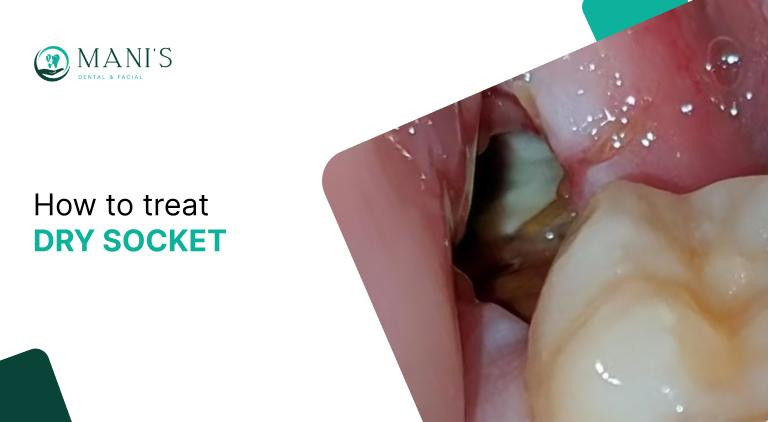A somewhat common, albeit unpleasant, dental disease that follows tooth extraction - especially of a wisdom tooth - is called a dry socket. It results from the blood clot that was forced out of the tooth socket when it was extracted before the wound had a chance to heal. Sharp aches may arise from this exposure of the underlying bone and nerves, which may lead to problems. Having knowledge about the causes, symptoms, treatment options, and prevention of dry socket syndrome can help one manage and prevent this excruciating condition.
Causes of Dry Socket
Although the precise origin of dry sockets is not always known, a number of variables can increase the likelihood of this result. Among them are:
- Trauma During Tooth Extraction: A traumatising extraction causes the blood clot to come loose. This can be the result of using too much force during extracting.
- Smoking: Nicotine hinders gum healing by reducing blood flow to the area. Moreover, the clot can be physically removed by sucking on a cigarette.
- Oral Contraceptives: Elevated oestrogen levels impede the healing process and raise the likelihood of developing a dry socket.
- Poor Oral Hygiene: Issues may arise if oral hygiene is neglected both before and after extraction.
- Previous History of Dry Socket You: will probably get a dry socket again if you have had one previously.
- Infections: The formation of the clot would be hampered if there was an infection at the extraction site prior to the extraction.
Dry socket symptoms
Dry socket symptoms are not subtle; in fact, they are typically far greater than the agony you would anticipate after having a tooth out. Symptoms include:
- Intense Pain: Usually beginning two to four days following the extraction, pain can radiate to the neck, temple, ear, or eye on the same side as the location of the extraction.
- The appearance of an Empty Socket: There will be a visible bone or an empty, dry socket at the extraction site.
- Halitosis and Unpleasant Taste: An infection may develop on the exposed bone, and this infectious stage typically results in halitosis and a sour taste.
- Swelling and Inflammation: It could cause swelling and inflammation in the surrounding tissues.
Diagnosis of Dry Socket
You need to consult an oral surgeon or dentist right away if you have a dry socket. They will examine the extraction site and may even perform an X-ray to check for the presence of anything, such as a bone fragment. Usually, the diagnosis is made solely on the basis of the look and symptoms.
How to treat dry socket
Prompt pain relief and averting additional problems are reasons to seek treatment. Let's examine dry socket treatment in more detail.
Socket Cleaning: In order to clean the socket and prevent infection or pain, a dentist flushes it to remove food particles and other waste.
- Medicated Dressings: A medicinal dressing or paste, applied by the dentist, soothes the socket's acute pain and promotes additional healing. Usually, the dressing is changed out after a few days.
- Pain Management: To relieve the discomfort, consider over-the-counter medications such acetaminophen or ibuprofen. If necessary, the dentist will recommend stronger painkillers.
- Antibiotics: Antibiotics will be provided if an infection is suspected.
- Self-Care: Rinse the mouth gently with saline or a recommended mouthwash to maintain cleanliness. Using a straw when drinking, abstaining from smoking, and practising proper dental care are further safety measures.
Prevention of Dry Socket
In both the pre- and post-extraction care, dry sockets are avoided. These are the successful techniques:
Pre-Extraction Preparation
- Provide details about any medications you are taking along with your medical history.
- If you smoke, attempt to give it up a few days prior to extraction and avoid smoking for the first 48 hours after extraction.
Care after Extraction
- Adhere to Dentist's recommendations: Pay close attention to the after-care recommendations that your dentist provides.
- Steer clear of smoke and straws: sucking moves the blood clot.
- Preserve Oral Hygiene: Brush your teeth gently, being sure to avoid the area next to the extraction site.
- Soft Diet: Remain away from chewing on the side of the extraction site and limit your intake to soft meals.
- Fluids and Rest: To promote healing, drink enough of liquids to stay well-hydrated, and get as much rest as you can.
When to Seek Help
See your dentist right once if you experience excruciating pain that doesn't seem to go away when you take painkillers, if there is an obvious empty socket, or if you experience infection-related symptoms like fever and swelling following a tooth extraction. In this instance, prompt action from the outset can greatly shorten the time that pain and other consequences last.
Conclusion
A painful condition known as a "dry socket" might make the healing process following extraction more difficult. In order to take the appropriate precautions and treat dry sockets, it is necessary to comprehend its origins and identify symptoms as soon as possible. If you have severe pain or any other symptoms related to dry socket, get in touch with your dentist for the necessary treatment. If you take preventative measures and adhere to your dentist's instructions to guarantee a speedy recovery following tooth extraction, you can lower these risks.
To know more, visit - https://www.manisdentalclinic.com/blog/how-to-treat-dry-socket/

